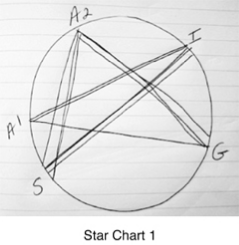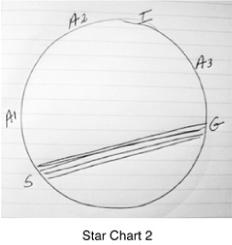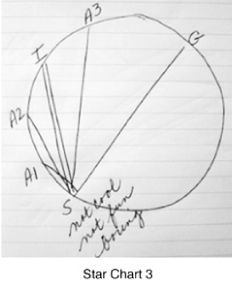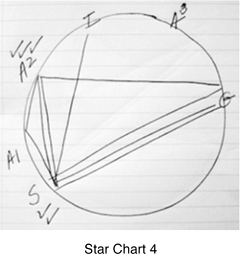Formative assessment:
Star charts
I like the idea of improving discussion circles by drawing maps to record who talks to whom and sharing the maps with my students. Rick Duvall explained this visual in a workshop. The Sunburst Evaluation forms, as he called them, are used to assess participation in literature circles.
 I call them Star Charts because if participants share equally, the drawing of the conversation looks like a star. (Star Chart 1) Since my goal is to decrease teacher talk and increase student contributions, this analysis technique seems perfect.
I call them Star Charts because if participants share equally, the drawing of the conversation looks like a star. (Star Chart 1) Since my goal is to decrease teacher talk and increase student contributions, this analysis technique seems perfect.
A Story of How Star Charts Work
My 3rd-grade group prepares by reading their novel silently and marking their questions. They post sticky notes on the pages before they come to discuss with one another. Then, five children sit with me around a table discussing Who Was Albert Einstein? by Jess Braillier and Robert Andrew Parker. My reading group is midway through the book at the time of this trial demonstration.
 I don’t tell the students I am making a map. I want baseline information first: to observe if certain students did indeed carry the conversation, if some students never contribute, and if students prefer to direct their comments to me.
I don’t tell the students I am making a map. I want baseline information first: to observe if certain students did indeed carry the conversation, if some students never contribute, and if students prefer to direct their comments to me.
I draw a circle in my daybook. I label the children in the order in which they sit and by the first initials of their names: S, A, J, I and G. In Start Chart 1, when S talked to G, I draw a line to show the relationship of the conversation. When G responded, I draw a line back to S.
I begin mapping as soon as Student S speaks. Students S and G talk back and forth to one another. None of the other students join the conversation. They watch Student S and Student G talk for a full two minutes. At that point, I decide to stop the group and show them the map I’d made.
Quickly, the group sees that not everyone contributed to the conversation. The students accept my challenge to involve everyone.
 In Star Chart 3, Student S starts the group off with a question. I map for about five minutes. As the conversation slows, I take the opportunity to show them the new map. From the visual, the students reflect.
In Star Chart 3, Student S starts the group off with a question. I map for about five minutes. As the conversation slows, I take the opportunity to show them the new map. From the visual, the students reflect.
Everyone is excited to see that each child contributed this time. They notice that since student S posed the question, participants addressed comments to her. I tell the students that I am pleased they didn’t talk to me but made eye contact with the questioner.
By this point, the children are eager to show me that they can make a star. The last question is intriguing. I am happy to map and watch what they do. Student S asks why Einstein’s father is so mad at his son the whole time he grew up (Star Chart 4). Student S reads from the book to point out his confusion: “…his father grew angry at Einstein.”
 The students work pretty hard to figure this one out, but it is above their reach. When they begin inferring wildly, I join the discussion as a participant. I tell these young readers that there are at least two definitions of “grew.” On the board, I draw a picture of a baby plant and a mature one to show one definition. So that the children understand the definition used in the book, I ask volunteers to act out what it looks like to grow madder and madder.
The students work pretty hard to figure this one out, but it is above their reach. When they begin inferring wildly, I join the discussion as a participant. I tell these young readers that there are at least two definitions of “grew.” On the board, I draw a picture of a baby plant and a mature one to show one definition. So that the children understand the definition used in the book, I ask volunteers to act out what it looks like to grow madder and madder.
“Oh,” said Student I looking at Student J. “I’m glad you asked that question. I didn’t understand it either.” Up to this point, Student I had been silent as evidenced by Star Chart 4.
Conclusions
The map provides a clear graphic of who is involved and who isn’t. By stopping periodically to show the map to the students, the students are able to set goals and work on them right away. Students find the mapping engaging and work to involve each person. Comprehension deepens because students know what to do: share perspectives, actually go back to the book and reread confusing parts, offer explanations, and look at one another. Acting as a recorder allows me to praise specific behaviors.
This group had come quite far in their 30-minutes together. The students set new goals on the spot for their next meeting: (1) continue to give everyone a chance to participate and (2) use the words in the book to support our ideas. They hadn’t made a star yet, but they came very close.
Procedural Steps for Star Charts:
- Make a baseline map of a small-group discussion.
- Explain a Star Chart to children. Share the objective: to engage each person in the conversation about books or math or content.
- Map for 3-5 minutes and then share how it’s going with the students. Ask them to analyze the map. Set a goal for the next few minutes.
- Repeat step 3 as often as you need or until time runs out. Set goals for the next group meeting.
Extension for moving beyond simple participation:
- To move beyond simple participation, invent codes to share with students. I watch for 4 main behaviors in discussion: ask a lead question, sustain conversation about one question, reference the text, and encourage one another. Create a code to add to your map for each: √ to show when someone references the text, + when a child builds on another child’s idea, R when a student references the text or other connections that help, for example.
- Take notes: record when someone invites another person into the conversation, record the questions that were asked, or make notes of the compliments, to name a few. The notes and codes help you know what to praise at the end of the discussion.
- Keep the star charts as evidence of progress in discussion circles.